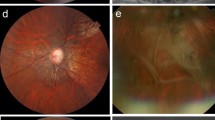Abstract
Purpose: To present a patient who has night blindness with a depolarizing pattern of ON/OFF response by electroretinography (ERG). Case: A 43-year-old woman had had night blindness and poorly corrected visual acuity since childhood. Parental consanguinity was noted. The patient had suffered from mental retardation, epilepsy, and mild cerebellar ataxia. Corrected visual acuity was 20/30 in the right eye and 20/25 in the left. Goldmann perimetry showed no scotoma but slight depression with internal isoptors. No evidence for rod activity was observed by Goldmann–Weekers adaptometry. The ocular fundi appeared normal. Methods: Conventional full-field ERGs to scotopic (dim and bright flash) and photopic (bright flash and flicker) stimuli were recorded. Photopic ERG responses to long flash stimulation (200 ms) were also examined. Results: The scotopic responses to dim flash were non-recordable, while those to bright flash were severely reduced. The photopic responses to bright flash were decreased. The amplitudes of flicker responses also were significantly decreased, and the implicit times of those responses were prolonged. Although the amplitudes of a- and d-waves to long flash stimulation were reduced, those of the b-wave were within normal range. The implicit times of a-, b- and d-waves were significantly prolonged. The patient showed a normal rise for the photopic b-wave but lacked a normal falling slope after the b-wave peak. An OFF-response late-negativity was also noted. Conclusions: The abnormal ON/OFF response found in the patient could be diagnosed as depolarizing pattern, characterized by elevation of the plateau to a positive potential above the prestimulus baseline. Since the ERG waveforms and clinical features found in our patient were different from those in previous reports, her ERG findings might reflect another retinal physiological mechanism.
Similar content being viewed by others
References
PA Sieving (1993) ArticleTitlePhotopic ON- and OFF-pathway abnormalities in retinal dystrophies Trans Am Ophthalmol Soc 91 701–773 Occurrence Handle1:STN:280:ByuC1cbgtlU%3D Occurrence Handle8140708
MF Marmor GB Arden SEG Nilsson E Zrenner (1989) ArticleTitleStandard for clinical electroretinography Arch Ophthalmol 107 816–819
T Usui N Tanimoto M Takagi S Hasegawa H Abe (2001) ArticleTitleRod and cone a-waves in three cases of Bietti’s crystalline chorioretinal dystrophy Am J Ophthalmol 132 395–402 Occurrence Handle10.1016/S0002-9394(01)00963-1 Occurrence Handle1:STN:280:DC%2BD3MvoslOltA%3D%3D Occurrence Handle11530054
DC Hood DG Birch (1997) ArticleTitleAssessing rod photoreceptor activity with the a-wave of electroretinogram: applications and methods Doc Ophthalmol 92 253–267 Occurrence Handle1:STN:280:DyaK1c7jslSktg%3D%3D
DC Hood DG Birch (1995) ArticleTitlePhototransduction in human cones measured using the a-wave of the ERG Vis Res 35 2801–2810 Occurrence Handle1:STN:280:BymC3cznsF0%3D Occurrence Handle8533321
D Yonemura K Kawasaki N Shibata et al. (1974) ArticleTitleThe electroretinographic component of the human excised retina Jap J Ophthalmol 18 322–333
KT Brown K Watanabe (1964) ArticleTitleIsolation and identification of a receptor potential from the pure cone fovea of the monkey retina Nature 193 958–960
WS Baron RM Boynton (1974) ArticleTitleThe primate foveal local electroretinogram: An indicator of photoreceptor activity Vision Res 14 495–501 Occurrence Handle10.1016/0042-6989(74)90038-8 Occurrence Handle1:STN:280:CSqD3s7jvFI%3D Occurrence Handle4214266
J François G Verriest A Rouck Particlede C Dejean (1956) ArticleTitleLes fonctions visuelles dans l’héméralopie essentielle nougarienne Ophthalmologica 132 244–257 Occurrence Handle13388255
TP Dryja LB Hahn T Reboul B Arnaud (1996) ArticleTitleMissense mutation in the gene encoding alpha-subunit of rod transducin in the Nougaret congenital stationary night blindness Nature Genet 13 358–360 Occurrence Handle10.1038/ng0796-358 Occurrence Handle1:CAS:528:DyaK28XktVegtL0%3D Occurrence Handle8673138
MA Sandberg BA Pawlyk J Dan B Arnaud TP Dryja EL Berson (1998) ArticleTitleRod and cone function in the Nougaret form of stationary night blindness Arch Ophthalmol 116 867–872 Occurrence Handle1:STN:280:DyaK1czkslKhsw%3D%3D Occurrence Handle9682699
T Rosenberg M Haim Y Piczenik SE Simonsen (1991) ArticleTitleAutosomal dominant stationary night blindness: a large family rediscovered Acta Ophthalmol 69 692–702
A Gal U Orth W Baehr E Schwinder T Rosenberg (1994) ArticleTitleHeterozygous missense mutation in the rod cGMP phosphodiesterase beta subunit gene in autosomal dominant stationary night blindness Nature Genet 7 64–67 Occurrence Handle10.1038/ng0594-64 Occurrence Handle1:CAS:528:DyaK2cXksFGitbc%3D Occurrence Handle8075643
TP Dryja EL Berson VR Rao DD Oprian (1993) ArticleTitleHeterozygous missense mutation in the rhodopsin gene as a cause of congenital stationary night blindness Nature Genet 4 280–283 Occurrence Handle10.1038/ng0793-280 Occurrence Handle1:CAS:528:DyaK3sXltlKku78%3D Occurrence Handle8358437
YW Peng Y Hao RM Petters F Wong (2000) ArticleTitleEctopic synaptogenesis in the mammalian retina caused by rod photoreceptor-specific mutations Nature Neurosci 3 1121–1127 Occurrence Handle1:STN:280:DC%2BD3M%2Flt1ehtg%3D%3D Occurrence Handle11036269
E Banin AV Cideciyan TS Alemán RM Petters F Wong AH Milam SG Jacobson (1999) ArticleTitleRetinal rod photoreceptor-specific gene mutation perturbs cone pathway development Neuron 23 549–557 Occurrence Handle10.1016/S0896-6273(00)80807-7 Occurrence Handle1:CAS:528:DyaK1MXltVynurg%3D Occurrence Handle10433266
Author information
Authors and Affiliations
Rights and permissions
About this article
Cite this article
Usui, T., Tanimoto, N., Ueki, S. et al. Night Blindness with Depolarizing Pattern of ON/OFF Response in Electroretinogram: A Case Report. Doc Ophthalmol 111, 15–21 (2005). https://doi.org/10.1007/s10633-005-3158-1
Accepted:
Published:
Issue Date:
DOI: https://doi.org/10.1007/s10633-005-3158-1




